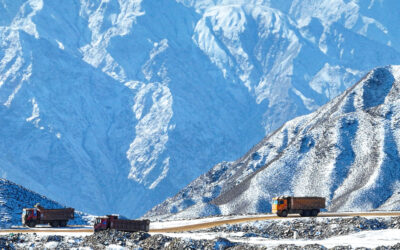
Can the CIA and U.S. military stop the Mexican cartels?
CIPHER BRIEF REPORTING — On January 20, the first day of his second term, President Donald Trump formally labeled Mexico’s crime cartels as international terrorists. Last […] More
OPINION — The delayed launch of the Artemis I, unmanned space craft to the moon provides a moment to review the enormous advances taking place in space activity.
We find evidence of that in last Wednesday’s Atlantic Council webinar that dealt with the release of the 110-page State of the Space Industrial Base 2022; Winning the New Space Race for Sustainability, Prosperity and the Planet, published by the Pentagon’s Defense Innovation Unit, U.S. Space Force (USSF), and the Air Force Research Laboratory.
Written by four senior USSF officials and based on two workshops held earlier this year with more than 250 government, industry and academic participants, this is the fourth annual report that assesses U.S. progress in retaining leadership in an increasingly competitive, strategic space race.
Reading it, I was drawn to a section of the USSF report that claimed, “commercial space technology has profoundly changed the character of conflict.”
It described how “months before February’s invasion of Ukraine, commercial remote sensing satellites provided early indications and warning of Vladimir Putin’s intentions. Armored columns literally had no place to hide regardless of day, night or inclement weather conditions. Unclassified images were readily accessible by government leaders, the media and the public providing Ukrainians valuable time to prepare.”
The Cipher Brief Threat Conference is happening Oct 9 -11. Can your national security-focused organization afford to miss it? Request your seat at the table.
The report explained that “once the conflict was underway, commercial satellite communications became the lifeline for disbursed tactical units to maintain situational awareness while sharing video and digital images of Russian atrocities for all the world to see. At the strategic level, President Zelensky’s ability to communicate with the outside world via commercial satellite communications was never interrupted.”
Commercial cloud computing platforms, the analysis said, “processed vast amounts of open-source data and imagery using computer vision algorithms to identify bomb damage to churches, schools and civilian housing. Hence, the United Nations has been able to accurately track the scale of destruction with daily precision.”
Thanks to small satellites, “Russian interference with GPS signals over land and sea was detectable,” according to the report. Therefore, it concluded, “The agile nature of commercial space innovation has significantly aided a small nation in its defense, while slowing the offensive of a great regional power.”
The USSF report shows there were 698 remote sensing satellites in orbit as of December 2021, according to National Geospatial-Intelligence Agency (NGA), with the U.S. having the most, at 370. However, NGA projected growth in the next decade could see some 5,300 such satellites in space with the U.S. share dropping to roughly one-quarter of the total.
For U.S. companies, the commercial sensing satellite business extends beyond the Defense Department and other U.S. government agencies, such as Agriculture and Homeland Security, to include private and commercial users such as the news media industry.
American participants in the working groups stated they face significant difficulty in competing with international remote sensing companies because they may develop technologies that by law, cannot be sold and exported abroad. Foreign companies do not face the same barriers.
In the broader sense, the USSF report found that “Strategic competition in space remains a paramount concern – China continues to compete toward a strategic goal of displacing the U.S. as the dominant global space power economically, diplomatically and militarily by 2045, if not earlier.”
To meet the challenge, the report said, “An enduring North Star vision for America in space” is needed. The workshop participants recommended, “’Economic Development and Human Settlement’ as that vision to retain U.S. economic leadership, motivate the American people, and protect U.S. national interests.”
Another theme that emerged from the workshops was, “In order to protect the planet, we must get off the planet. Advancements in world power production, manufacturing and Lunar resource extraction will be foundational to the trillion-dollar space economy. Enabling strategy, policy, and laws will be required to lead in an enlightened and effective effort.”
Among the more dramatic statements in the report was that “The New Space Race seeks to achieve nothing less than the permanent establishment of the first off-Planet human settlement propelled and sustained by a thriving to-, in-, and from-space economy. It will be forged from a Cislunar [between the Earth and the moon] industry that knits together the physical, digital and power infrastructure required to support the future needs of Earth, and to extend human activity to Mars and beyond…Economic development and human settlement in space will clearly have the most profound, long-term impact on preserving Earth’s biosphere. Choosing to remain terrestrially rooted with spiraling populations and industrialization is not a viable alternative.”
To make the case that space is a growing business, the USSF report noted that “2021 was a record-breaking year for the U.S. Space Industrial Base. According to BryceTech, a total of $15.4 billion was invested across 241 start-up space ventures during 2021, smashing the previous record of $7.7 billion invested during 2020.”
It added that the new space economy is expected to exceed $1 trillion by 2040.
The launches that take place are one measure of space growth, with more occurring worldwide in 2021, than in any previous year. According to the USSF report, “Several years ago, Cape Canaveral saw a couple launches a year; last year, there were 31 launches of which 84% were commercial.” China completed 55 space launches in 2021, with 60 more planned in 2022.
The USSF report added, “The number of small satellite launches is expected to double from 428 in 2021, to 814 in 2022.”
SpaceX has its Starlink network, which launched on low-Earth-orbit 989 new satellites in 2021 out of 19 of its Falcon launches. SpaceX’s Starlink operation has regulatory approval to launch more than 12,000 of the small satellites in multiple orbital planes, providing commercial users with line-of-sight access to space-based broadband signals from any point on Earth.
The Cipher Brief hosts expert-level briefings on national security issues for Subscriber+Members that help provide context around today’s national security issues and what they mean for business. Upgrade your status to Subscriber+ today.
Meanwhile, Amazon has contracted for 83 future launches for its $10 billion Kuiper system’s projected low-Earth-orbiting 3,236 satellites, which would provide high-speed internet anywhere in the world. The first two are scheduled to launch later this year. Overall, it was the largest such launch procurement in history, and Amazon plans to have half of its satellites deployed by 2026, according to its FCC license. Early service from Kuiper is set to begin once Amazon has 578 satellites in orbit.
If current trends continue, the USSF report said that the satellite numbers in low-Earth-orbit “may grow as high as 50,000 satellites over the next 10 years, many of which will only be detected infrequently” by current U.S. space surveillance network systems. That will cause a demand for more space traffic management sensors which in turn, will create more gaps in current space surveillance networks.
Geostationary Earth Orbit (GEO) satellites are some 22,000 miles above the Earth that appear to be stationary in the sky. According to the USSF report, the U.S. “increasingly in GEO, and eventually beyond GEO, is not postured to adequately execute intelligence and space traffic management missions.”
“Without addressing the space domain awareness challenge identified above, and without allocating a budget in line with the scale of this need, the U.S. cannot effectively sustain its
leadership in space traffic management across all altitudes and regions,” the USSF report said.
“Space is the next great frontier for economic development and human settlement. Like the
exploration and settlement of the West, space offers new opportunities for realizing the American dream,” the USSF report said.
It might be a good idea to incorporate U.S. national security into that broader dream.
Read more expert-driven national security insights, perspective and analysis in The Cipher Brief
Related Articles

CIPHER BRIEF REPORTING — On January 20, the first day of his second term, President Donald Trump formally labeled Mexico’s crime cartels as international terrorists. Last […] More

EXPERT INTERVIEWS — The Office of the Director of National Intelligence (ODNI) marks an anniversary today — 20 years since its creation as the top oversight […] More

DEEP DIVE — When the U.S. intelligence community (IC) declared last week that the greatest danger to American national security is old-fashioned organized crime – mainly […] More

DEEP DIVE — Over the past week, the Trump administration took two steps involving the pursuit of critical and rare earth minerals: it issued an executive […] More

DEEP DIVE — President Donald Trump’s foreign aid freeze will kneecap U.S. efforts to build alliances around cybersecurity issues and help Russia and China seize the […] More

EXPERT INTERVIEWS – In an age of rapidly changing technology and profound implications for the wars of the future, is the United States adapting effectively, […] More
Search